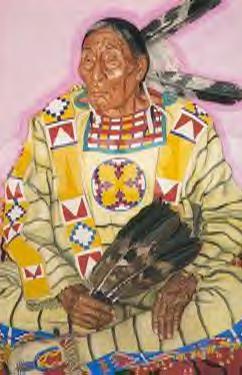|
|
Keeping the Flame Alive
Native Elders Find Inspiration, Comfort in Traditional Dancing
by Dorreen Yellow Bird Herald Staff Writer
 Wacipi audiences
are sometimes amazed as they watch dancers fast-step for almost an hour nonstop. It is even more remarkable when
that person is over 50 years old. Wacipi audiences
are sometimes amazed as they watch dancers fast-step for almost an hour nonstop. It is even more remarkable when
that person is over 50 years old.The 31st annual Time Out Wacipi at UND's Hyslop arena was once again full of the sounds of drums and powwow songs Saturday. It was also filled with the jingle of the dancers' bells and the clicking together of deer hooves. Even though the early afternoon crowd was light, more people came in the evening as the dances became more competitive with the adult men and women divisions dancing for prize money. "It (dancing) has helped me survive in this world. It is saying it is all right to be Indian," said 53-year-old Bob St. John, a Sisseton Wahpeton Dakota Sioux dancer from Sisseton, S.D. There was time when it was hard to be an Indian because society "made fun" of you, he said. For St. John that is in the past. He takes his family on the powwow circuit most weekends during the spring, summer and fall. They may attend as many as 30 powwows in that time. They were called "doings" back when he was a child, he said. St. John grew up the powwow way. His father, Edward, was a singer and a champion moccasin game player. It is one of the games played at some powwows. In this game, the participants gamble by hiding and guessing the whereabouts of an object hidden under their moccasins. His family was traditional and took care of the health needs of the family, too. Healing was "normal everyday" stuff for us, he said. "If you got sick, the grandparents took care of us." St. John was given his grandfather's name, "Napa Sni Duta," which means "Not Afraid of Red." This is the story he was told about the way his grandfather got that name: He said his grandfather was wounded as he was riding toward Canada. It was a bad wound and he tied the injury with his belt to keep his intestine inside. The red blood ran over the belt and onto his horse. Napa Sni Duta sang his death song and made it to the Canadian border before he died. He is buried there, St. John said. His grandfather was a member of the Little Crow Band -- Napa Sni Duta was the grandson of Little Crow. St. John said his four children dance. They also know about eagle feathers, sweats, pipe and other ceremonies. They also know the songs to use for those ceremonies. He dances with an old warrior-style Dakota Sioux outfit. The bustle comes from his wife's grandfather, who lived in Montana. A bustle is worn on the backside of the dancer's outfit. He said he made the bustle bigger. But it is smaller than the bustles used by most dancers because the old style was made "so that you could jump on your horse and ride with it on," he said. The background of the outfit is blue, a traditional color for the Sioux. "It took me a long time to place at the powwows," he said, "because judges didn't recognize this old style of outfit. Dancers are usually judged by their dance style, how well they stay on the song -- that means they know the song if they stay with it and they are also judged by their outfits." St. John works at the Veterans Hospital in Fargo. Began 7 years ago Another dancer at the Wacipi was 52- year-old Marian Anthony, who is Turtle Mountain Chippewa. She started traditional dancing only seven years ago. It was a good friend, who passed on, who turned her toward the spiritual world and showed her the native ways. It brought her inner peace to dance, she said. "When you are moving in time with the music, you don't know what is going on around you," she said. She watched dancers from the powwows and picked out the outfit she wanted and put it together herself -- beaded everything, she said. Three of her four children started dancing five years ago. The Time Out Wacipi is the first time that she has tried competition dancing. "In the traditional dancing," she said, "you're not pressured." They are there to have a good time. Anthony works at the Grand Casino at Mille Lacs, Minn. She lives in Brainerd, MN. |
|
|
| Canku Ota is a free Newsletter celebrating Native America, its traditions and accomplishments . We do not provide subscriber or visitor names to anyone. Some articles presented in Canku Ota may contain copyright material. We have received appropriate permissions for republishing any articles. Material appearing here is distributed without profit or monetary gain to those who have expressed an interest. This is in accordance with Title 17 U.S.C. section 107. |
|
Canku Ota is a copyright of Vicki Lockard and Paul Barry. |
|